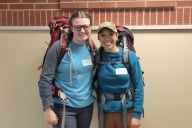You have /5 articles left.
Sign up for a free account or log in.
Consortium organizations dedicated to supporting digital learning and technology efforts at member institutions remain valuable even as a few have closed in recent years, according to a new report this month from the WICHE Cooperative for Educational Technologies (WCET).
The report, written by WCET’s Russell Poulin and Terri Taylor Straut, is a sequel of sorts to the organization’s 2008 survey, offering an opportunity to reflect on how the role of consortia has changed -- and how it has remained the same.
The original survey received responses from 39 organizations. Of those, five have since closed, while nine others have transitioned to new missions or changed their names.
The new survey received 32 responses from existing organizations -- 29 from the U.S. and three from Canada. The majority of respondents (27 of 32) exclusively serve public institutions, while four serve a mixture of privates and publics, and one serves exclusively private institutions.
Respondents were presented with a list of tasks and asked to identify the ones they tackle. The most commonly cited tasks were brokering partnerships between member institutions, contributing to faculty development and facilitating course sharing between members.
Other oft-cited activities included creating a joint online listing or course catalog, offering open educational resources, preparing students for online learning and operating a repository of online learning objects. Poulin and Strauss noted that far more consortia this time around identified OER, reflecting ongoing trends elsewhere in the sector.
Van Davis, principal at Foghlam Consulting who spent eight years coordinating interinstitutional collaboration in various roles at the Texas Higher Education Coordinating Board, said after reading the report that he sees solidifying evidence that institutions are growing more comfortable relinquishing their in-house grip on some of their core academic services.
“This jump in consortia-led faculty development might indicate that some institutions are much more comfortable outsourcing academic and student support services to institutional consortia that share common values and missions than vendors,” Davis said.
The big takeaway for Poulin, WCET’s director of policy and analysis, was the organizations’ increasing focus on exploring the possibilities of emerging technologies.
“Given the growing number of innovations that emerge every day, such cooperation is going to become more and more necessary,” Poulin said in an interview. “We can’t do it all on our own.”
The closure of several organizations has raised some questions about the long-term financial viability of organizations that aren’t directly serving students. Indeed, the report finds that almost two-thirds of these organizations rely on one or two funding streams, and many organizations that have more than two streams tend to get most of their funding from one source.
“While there is more diversity now in revenue streams than in 2008, many of these organizations are still at risk to changes in governments, changes in system or institutional leadership and priorities, economic downturns, and other overseen occurrences,” the report reads.
While these organizations clearly span a wide range of responsibilities, some tasks continue to fall outside their purview. A majority of respondents listed academic portfolio reviews, open textbooks, transfer agreements between institutions and academic advising as activities they don’t handle.








